
First and Only Weekly Online Fanzine Devoted to the Life & Works of Edgar Rice Burroughs
Since 1996 ~ Over 10,000 Web Pages in Archive
presents
Volume 2342

 .
. 
Edgar Rice Burroughs |
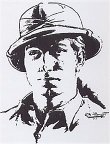 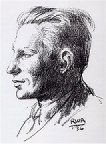
L. Ron Hubbard |
|
EARLY ADVENTURES Both men were from families noted for their pioneer spirit and both were dreamers who had a wanderlust, which led them through many personal adventures in the "wild west." and far east. |
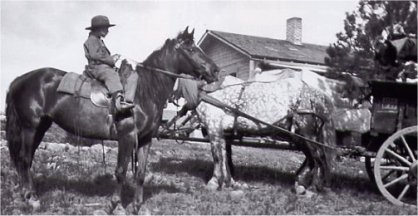
Young LRH on the family Montana ranch |
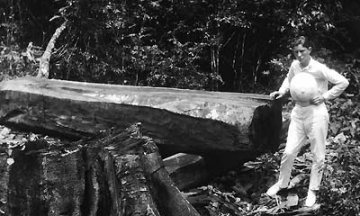
LRH in Guam 1928 |
| LRH spent his early years in Big Sky Country
on the family ranch, the "Old Homestead,"
near Helena, Montana. When not riding horses and breaking broncs, he was
tutored by his cultured mother who taught him to read and write before
the age of 3 1/2. He spent much time with Old Tom, a Blackfeet medicine
man, and developed a great appreciation of the heritage of Native Americans.
He lived the "frontier life" to the fullest -- even trying his hand at
being a prospector, unsuccessfully panning for gold. In 1918 he rode with
his grandfather in a Model T Ford on a "cross-country automotive adventure"
from Helena, Montana to Portland, Oregon and then made a solo train trip
to Tacoma, Washington.
Later he skipped school to follow his naval officer father to Guam from where he travelled to Hawaii, Japan, China, Hong Kong and the Philippines. After returning to the states to complete his high school and college education he joined three separate expeditions in 1931 and 1932. The first was made up of a team of GWU surveyers sent to verify the US-Canadian border in Maine. He then embarked upon a 2 1/2 month, 5,000-mile Caribbean Motion Picture Expedition with 50 college students, sailing on the schooner Doris Hamlin, one of the last of America's four-masted commercial ships. His third expedition was with the Puerto Rican Mineralogical Expedition on a survey of Puerto Rico. These exploits and other expeditions earned him membership in the renowned Explorers Club, which led to even more expeditions of discovery including the Alaskan Radio Experimental Expedition. |

The Doris Hamlin |
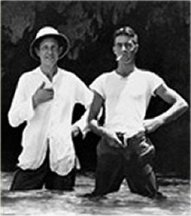 .
.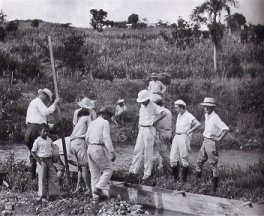
Puerto Rican Mineralogical Expedition |
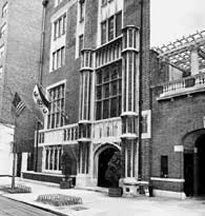
Explorers Club, NYC . |
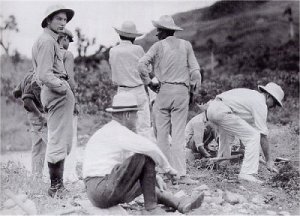
Puerto Rican Mineralogical Expedition . |
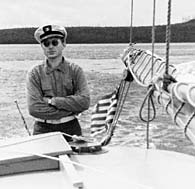
Explorers Club Flag #105 - 1940 Alaskan Radio Expedition |
| ERB was from good pioneer
stock going all the way back to family friend George
Washington. He was raised in Chicago, but as a young teen he spent
much time on his brothers' ranch in Idaho, where he experienced all the
excitement of the wild west. He lived the life of a cowhand, bronc buster,
mail rider, gold miner and spent an exciting time among cowpunchers, murderers,
horse thieves, and bad men.
Later, tiring of his teaching job at Michigan Military Academy, he joined the US Cavalry and went west. He was posted at Fort Grant in Arizona with the US 7th Cavalry. The experience of riding patrols sent out to track Apache renegades and meeting real westerners gave the young soldier military experience and appreciation of the culture of the American West. He developed a great respect for the Indian traditions, which is shown in the Apache novels he wrote many years later. This lust for adventure never left him even after "settling down" with a wife and three kids. In 1916 ERB took his family on a rugged 3527-mile cross-country journey by from Oak Park, Illinois to Los Angeles. |
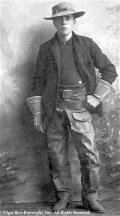
Young Ed: Idaho Cowboy |
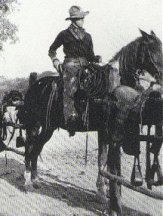
Cowboy Burroughs |
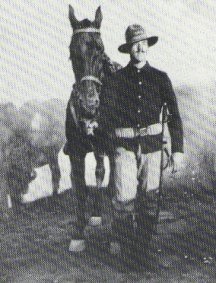
ERB: US Cavalry in Arizona |
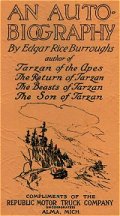
Cross-Country Adventure |
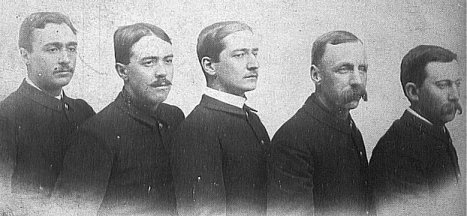
ERB with fellow troopers in the US 7th Cavalry |
|
EARLY INFLUENCES: STEPPING STONES & MENTORS The early years that LRH spent in Montana had a profound influence on him. He learned to ride by the age of three and grew up with colourful old frontier characters and cowboys. Old Tom, a Blackfeet Indian medicine man introduced him to the tribal customs and even conferred on his young friend the status of "blood brother." He became a dedicated student of the folklore of range riders, homesteaders, Indian tribes and the legends of the old American West. This firsthand experience fired his imagination and served him well in his future writing career. In 1923 LRH's father, a naval officer, was ordered to Washington DC. The family sailed from SF through the new Panama Canal to New York on USS Ulysses S. Grant. During the voyage he met a student of Sigmund Freud - US Navy Commander Joseph "Snake" Thompson - who introduced him to Freud's theories and encouraged him to pursue a study of the nature of the mind. Commander Thompson, a surgeon, was known throughout the Navy as "Snake" because of his herpetology interests and publications. The Navy sent him to study under Freud. He met a 12-year-old LRH and having no boys of his own, piqued his interest in the mind and many other subjects. Following the voyage he set him down in the Library of Congress and Smithsonian Institute. In 1928 he took the USS Henderson from San Diego to visit his father who was stationed in Guam. From there he went on to visit many Asian countries: travelling inland through China to Beijing's Forbidden City, Japan, Philippines, and Java. During this time he was influenced by a British intelligence officer, Buddhist priests, and a man descended from magicians in the court of Kublai Khan. |
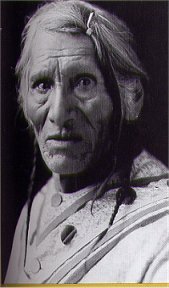
Old Tom - Blackfeet Medicine Man |
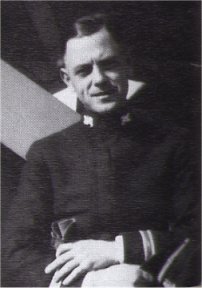
Joseph "Snake" Thompson |
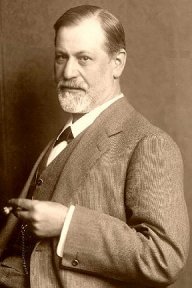
Dr. Sigmund Freud |
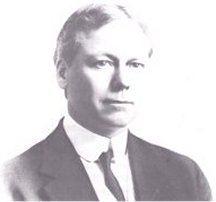 ERB's
writing too, was greatly influenced by the time he spent in the western
frontier in the late 19th century. His brothers and their partner, Lewis
Sweetser, brought the young ERB into their ranching and gold mining
operations in Idaho. Sweetser was a man of many talents - including writing.
While most of his writing delved into accounts of local history, his popular
lecture tours became increasingly involved with psychology, the occult,
powers of the subconscious, hypnotism, and promoting his powers as a psychic.
ERB had few leanings in this direction, but there is a good chance that
Sweetser's interests would have had some effect on the young Burroughs
runaway imagination. ERB's
writing too, was greatly influenced by the time he spent in the western
frontier in the late 19th century. His brothers and their partner, Lewis
Sweetser, brought the young ERB into their ranching and gold mining
operations in Idaho. Sweetser was a man of many talents - including writing.
While most of his writing delved into accounts of local history, his popular
lecture tours became increasingly involved with psychology, the occult,
powers of the subconscious, hypnotism, and promoting his powers as a psychic.
ERB had few leanings in this direction, but there is a good chance that
Sweetser's interests would have had some effect on the young Burroughs
runaway imagination.
ERB's reading interests leaned to material about the military, especially novels by General Charles King and books on Roman history: Caesar's Commentaries, Macauley's Lays of Ancient Rome and the works of Gibbon. He found excitement in the vigorous style, stirring narrations and martial tone of these authors. Other favourite authors included George Barr McCutcheon (Graustark novels), Anthony Hope (Prisoner of Zenda), Richard Haliburton, Mark Twain, H. M. Stanley, Robert Service, H. H. Knibbs and later, Zane Grey and Jack London. ERB was a life-long Republican, taking a strong pro-military stance in most situations. He inherited his father's morality, devotion to the military, and belief in capitalism, which his fertile imagination molded into original science fiction, sword and fantasy, and adventure themes so often imitated by other writers in decades to come. ERB was tremendously influenced by General Charles King, a veteran of all the US military conflicts fought during his lifetime of nine decades. He also was ERB's commandant at Michigan Military Academy for a time and was a best-selling author of military adventures. ERB was almost certainly influenced by Buffalo Bill Cody, Carl Hagenbeck's Wild Animal Exhibit, and Nikola Tesla at the Chicago Columbian Exposition of 1893. Accounts of Africa by explorers such as Henry M. Stanley were also a major influence in his formative years. ERB returned to a position of assistant commandant and instructor of geology, gatling gun use, riding and drill at the Michigan Military Academy. A few years later he did well in the business world as a the head of the Secretarial Department of the Sears and Roebuck, Co. in Chicago. All of these influences played a major role in preparing him for a writing career which he began in 1911 at age 36. |
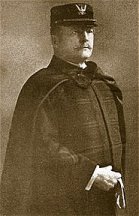
General Charles King |
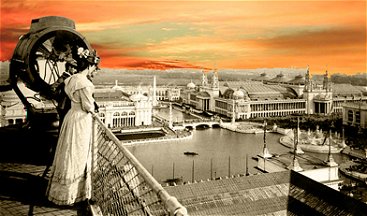
Chicago Columbian Exposition of 1893 |
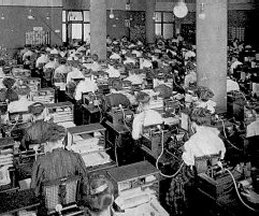
ERB department at Sears, Roebuck: Chicago |
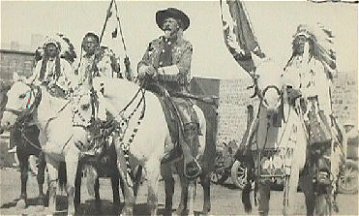
Buffalo Bill's Wild West Show at Columbian Exposition 1893 |
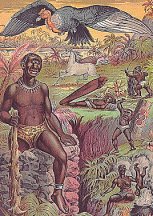
Heroes of the Dark Continent |
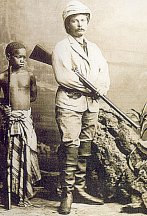
H. M. Stanley |
|
FIRST WRITING Both budding authors used their various school publications as a proving ground for their first attempts at writing. They kept lengthy journals in which they recorded the details of their colourful lives. LRH's first serious writing efforts were for the Helena High School paper, The Nugget. Using notes compiled in his ledger he wrote articles about his journeys in the Far East. These writing contributions continued while attending Swavely Prep School in Manassas, Virginia and the Woodward School for Boys in Washington, DC. He also a delivered prize-winning speech in an oratory contest. After enrolling in George Washington University he became a senior editor and writer for the GWU Hatchet. His first fiction stories -- based on experiences in the Far East -- were published in this paper: "Tah" and "Grounded" and the one-act play: "The God Smiles." |

LRH the Young Writer |
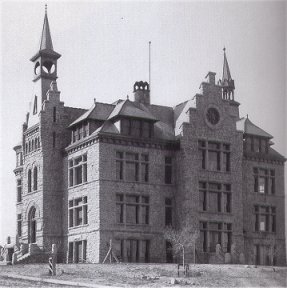
Helena High School |
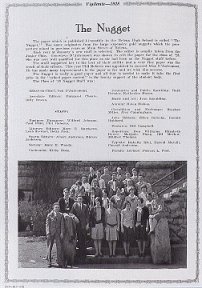
The Helena Nugget |
| Beyond his childhood sketches, letters and poems,
ERB's first attempt at serious writing was for the school magazines and
yearbooks of the various schools he attended (Phillips, MMA). Already his
creativity was in evidence, since as editor of these magazines, he wrote
news items, articles and sketched many of the cartoons and artwork for
each issue. The speech he delivered at the 1894
MMA graduation ceremonies has been reprinted in numerous publications
over the years.
After returning to Chicago and Oak Park, Ed had numerous poems published in local papers under the penname Normal Bean. During The Great War he wrote numerous patriotic articles for magazines and newspapers. The Burroughs archive contains a wealth of personal journals, books of newspaper clippings, and carbon copies from decades of correspondence. ERB's first "serious" writing was done in 1903 but was not published until a century later: Minidoka 937th Earl of One Mile Series M: An Historical Fairy Tale. Ed wrote numerous movie treatments and plays . . . the most notable being the one he wrote for his actress daughter, Joan: You Lucky Girl! Joan and her husband, James Pierce, eventually starred as Jane and Tarzan in the 1932 radio series, Tarzan of the Apes. All this early journalistic writing served him well many years later when he flew and sailed across Pacificana as the oldest accredited war correspondent in World War II. |
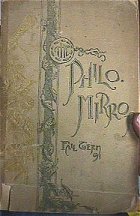
Phillips Yearbook |
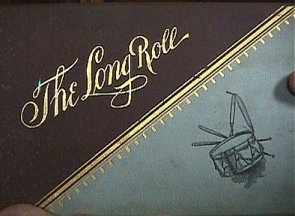
Michigan Military Academy Yearbook |
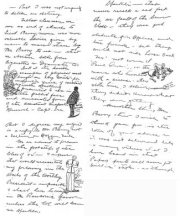
MMA Grad Speech 1894 |
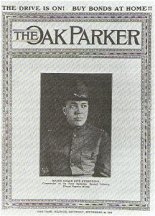
Oak Parker ~ Sept 18, 1918 |
|
OTHER ARTISTIC TALENTS Both men had an early interest in photography that they enjoyed for their entire lives with photo records of family, as well as their interests and travels. LRH had a lifelong interest in photography. In his archives, there are about 40,000 photographs which begin with photos he took for his Boy Scout merit badge in 1924 in Washington, D.C. They cover his early travels, which includes his apprenticeship and under Guam island photographer Thomas Mayhew, during which LRH took a series of phtos of the people and island that is, arguably, the best extant record of pre-WW II Guam. This marks the beginning of his professional career as a photographer as the photos sold to National Geographic, and he followed during his college years to sell to New York Times, Sportsman Pilot and Washington Herald. It continued through his time in Europe and at his estate in England, where he honed his photographic skills to perfection with the New York Institute of Photography correspondence course, while also using it as an area to test his theories on study and eduation. This period includes his award-winning photographs that were shown in European salons. The photographs continue right up through his final years in Southern California. He also had musical talent and wrote and often performed ballads for live audiences and on radio stations such as WOL. In the '80s he wrote the words and music for the Mission Earth soundtrack that was performed by Edgar Winter. |
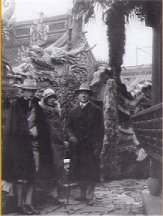
Beijing 1928: LRH Family |
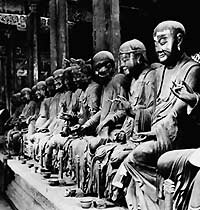
Temple Statues in Asia |
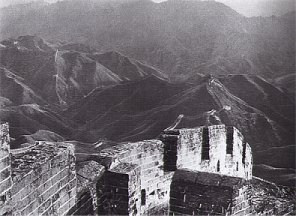
Great Wall of China |
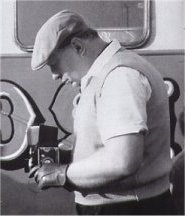
LRH the Photographer |
| One area of creativity that LRH and ERB did not share was skill with sketches and illustration. Edd Cartier said that once when he told LRH during their Golden Age collaboration that he wished he could write like LRH, Ron responded by saying, "Edd, I wish I could draw like you." (Don't we all!) |
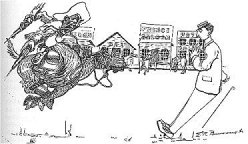 Although
ERB maintained a life-long interest in photography, his artistic ability
probably served him better careerwise. He had always loved sketching. There
are many sketches in the Burroughs archives from the time he spent in the
West and later he produced many excellent political cartoons and maintained
a day-to-day happenings journal presented exclusively through cartoon sketches.
ERB attended art school in Chicago for a short time and was always very
involved in recommending and approving illustrations for his novels. Although
ERB maintained a life-long interest in photography, his artistic ability
probably served him better careerwise. He had always loved sketching. There
are many sketches in the Burroughs archives from the time he spent in the
West and later he produced many excellent political cartoons and maintained
a day-to-day happenings journal presented exclusively through cartoon sketches.
ERB attended art school in Chicago for a short time and was always very
involved in recommending and approving illustrations for his novels.
ERB bought and ran a stationery/camera shop in Idaho in his younger days. The Burroughs Tarzana archives are brimming with photographs and movies from his early days in Idaho, Chicago, Oak Park and Tarzana. His interest in photography was passed on to his two sons who became expert photographers -- Hulbert served as a combat photographer in WWII and Jack used photography extensively in his art projects. |
| LRH instead, exercised musical talent. He apparently learned some fiddle skills from his grandfather, which he demonstrated during his early adventures in the Orient. During his college years, he wrote and performed ballads for live audiences on radio stations such as WOL in Washington, DC. In later years, he played the organ for his pleasure and in 1982 wrote the music for his book Battlefield Earth, which was released as "Space Jazz" performed by jazz legend Chick Corea and Gayle Moran and one of the "most important session musicians in rock history," Nicky Hopkins. This was followed in 1985 with LRH's music to accompany his magnum opus, the 10-volume science fiction satire, Mission Earth, performed by one of music's true pioneers, Edgar Winter. |
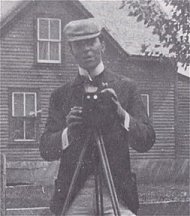
ERB in Pocatello, Idaho - 1898 |
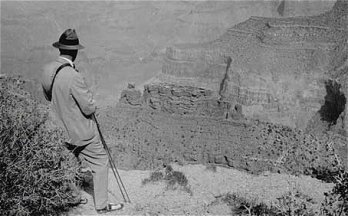
ERB on a Photo Tour of Grand Canyon |
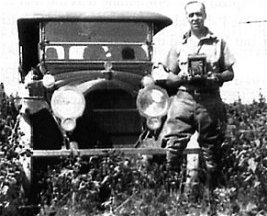
ERB and camera on a camping expedition |
|
TRUE LIFE ADVENTURES ON LAND, AIR AND SEA Both men had a great urge to travel and drew from their real-life adventures for inspiration in their storytelling. Many of their true life experiences were more exciting than the fictional adventures they penned. Over their lifetimes they logged countless miles over land and sea and through the air. Much of their incomes were devoted to these pursuits. Much of Hubbard's writing was based on his firsthand experiences at sea, or in the Far East. LRH had a lifelong love of the sea and earned licenses to operate ships on any ocean. In 1931 LRH took up glider flying and joined a pilot friend to barnstorm across the Mid-West. The first magazine article he sold was "Tailwind Willies" to the aviation journal, Sportsman Pilot |
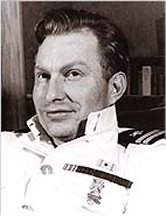
Lt. Hubbard (WWII) |
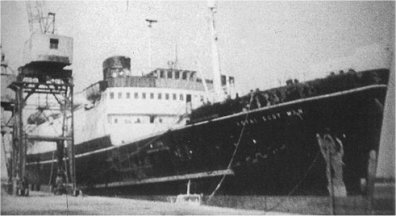
The Royal Scotman |
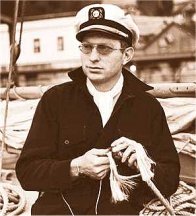
Alaskan Radio Expedition (1940) |
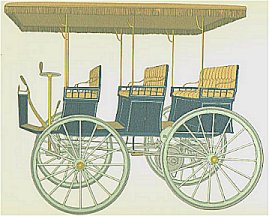
Ed's 1893 Electric Horseless Carriage |
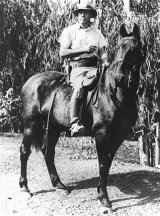
ERB at Tarzana Ranch |
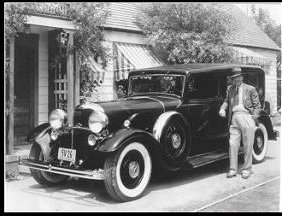
ERB and one of his Packards |
| ERB loved exploring by auto. He had driven the
first electric horseless carriage in Chicago at the Columbian Exposition
of 1893. Through his lifetime he owned many powerful cars: Packards, Cords,
Republic trucks. He sometimes dreamed of having his own boat and enjoyed
excursions at sea in boats owned by friends, although he once admitted
to becoming bored with the experience, except for when he piloted the crafts
himself. He settled for many liner cruises and took long trips on military
ships in WWII.
In the mid-1930s he earned his pilot licence and for a time was quite dedicated to the hobby - even purchasing his own aircraft. One time he flew over the mountains to Colorado to see his daughter Joan 's acting performance with a stock company. His enthusiasm cooled somewhat after his rookie-pilot son Hulbert crashed their brand new aircraft -- narrowly escaping serious injury. Not long after this he also learned that his flying instructor had died in an aircraft accident at an aeronatical exhibition. ERB's writing was of a highly imaginative nature, but upon close observation, many of his stories were also strongly influenced by his experiences as a cowboy, miner, cavalry man, policeman, stationery/camera store shopkeeper, rancher, traveller, multi-media businessman, Hollywood producer, WWII journalist, etc. |
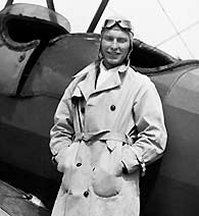
LRH with Bi-plane (1933) |
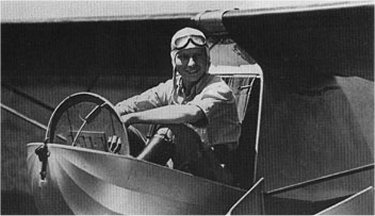
LRH Earning His Glider License - 1931 |
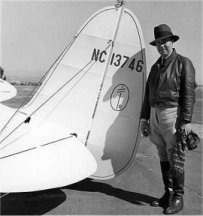
ERB and Airster "DooDad" |
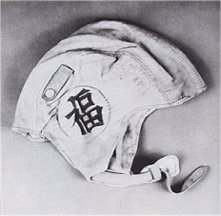
LRH Helmet with Japanese Good Luck Symbol From His Early Adventures |

ERB Colophone . |
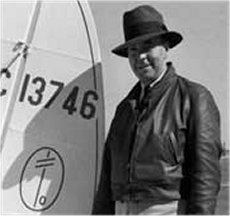
ERB's "Doo-Dad" Symbol . |
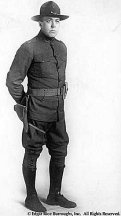
Army Officer |
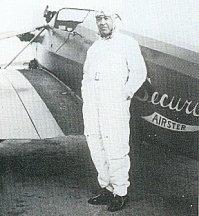
Pilot |
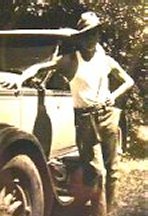
Auto Gypsy |

Outdoorsman |
|
|
|
|
|
|
|
|
![]()
![]()
BILL
HILLMAN
Visit
our thousands of other sites at:
BILL
and SUE-ON HILLMAN ECLECTIC STUDIO
ERB
Text, ERB Images and Tarzan® are ©Edgar Rice Burroughs, Inc.-
All Rights Reserved.
LRH
IMAGES © 1998 L. RON HUBBARD LIBRARY. ALL RIGHTS RESERVED.
All
Original Work ©1996-2009/2012 by Bill Hillman and/or Contributing
Authors/Owners
No
part of this web site may be reproduced without permission from the respective
owners.